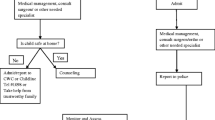Abstract
Justification
Pediatricians are usually the first point of contact of children with the health system. Studies worldwide have shown that there is insufficient knowledge about child abuse recognition and management among health workers. Presently no uniform guidelines exist in India for pediatricians regarding the appropriate response to child abuse.
Process
As part of the Child Rights and Protection Programme (CRPP) under IAP VISION 2007 of Indian Academy of Pediatrics, a ‘Training of Trainers (TOT) Workshop on Child Rights and Protection’ was held in Mumbai in January 2007. It was attended by participants from all over the country. The workshop recommended ‘developing country-specific teaching and training material’. A Task force of IAP CRPP was formed and it developed a module for ‘Training of Trainers Workshops for Pediatricians’. A National Consultative Meet was held in October, 2007 at New Delhi, where the program was discussed and ratified.
Objectives
To train pediatricians to: recognize and respond to child abuse; engage in a multi-disciplinary networking mode to deal with child abuse; and, document, record and report instances of child abuse.
Recommendations
Guidelines for recognition and management of child abuse are presented. All pediatricians should assess suspected harm with the same thoroughness and attention as they would do with a life threatening condition. Poor management after disclosure can increase psychological damage. Pediatrician should believe, support, reassure, treat and ensure rehabilitation of victims of child abuse, keeping the best interest of the child as the primary goal.
Similar content being viewed by others
References
Report of the Consultation on Child Abuse Prevention, 29–31 March 1999, WHO, Geneva. Geneva, World Health Organization, 1999 (document WHO/HSC/PVI/99.1). Available from http://whqlibdoc.who.int/hq/1999/aaa00302.pdf. Accessed on 22 November, 2009.
Study on Child Abuse: India 2007. Ministry of Women & Child Development, Government of India, Delhi, 2007. Available from http://wcd.nic.in/childabuse.pdf. Accessed on 21 November, 2009.
Convention on the Rights of the Child. United Nations Children’s Fund. Delhi, 2004.
Child Protection Companion. 1st Edition, RCPCH, London, 2006. Available on http://www.rcpch.ac.uk/Education/Education-Coursesand-Programmes/Safeguarding-Children. Accessed on 21 November, 2009.
Child Protection Reader. 1st edition, RCPCH, London, 2007. Available on http://www.rcpch.ac.uk/Education/Education-Coursesand-Programmes/Safeguarding-Children. Accessed on 21 November, 2009.
Agarwal K, Dalwai S, Galagali P, Mishra D, Prasad C, Thadani A. Manual on recognition and response to child abuse-the Indian scenario. Indian Academy of Pediatrics — Child Rights and Protection Programme (CRPP), Delhi, 2007.
Safeguarding children: Recognition and response in child protection. RCPCH Trainer CD ROM, 2006, London, 1st edition.
DGH de Silva, CJ Hobbs. Managing Child Abuse. A Handbook for Medical Officers. WHO SEARO, Delhi, 2004.
Kellog N. Evaluation of suspected child abuse and neglect. AAP Policy statement. Pediatrics 2007; 119: 1232–1241.
Kellog N. Evaluation of sexual abuse in children. AAP Policy statement. Pediatrics 2005; 116: 506–512.
Manual for Medical Officers. Dealing with Child Victims of Trafficking and Commercial Sexual Exploitation. Department of Women and Child Development, Government of India, New Delhi, 2007. Available from URL: http://wcd.nic.in/ManualMedicalOfficers.pdf. Accessed on 21 November, 2009.
The Physical Signs of Child Sexual Abuse — An Evidence-based Review and Guidance for Best Practice. Royal College of Paediatrics and Child Health, London, 2008.p.146–147. Also available from URL: http://www.rcpch.ac.uk/Research/CE/RCPCH-guidelines.
American Academy of Pediatrics. Sexually transmitted infections in adolescents and children. In: Pickering LK, Baker CJ, Long SS, McMillan JA, eds. Red Book: 2006 Report of the Committee on Infectious Diseases. 27th ed. Elk Grove Village, IL: American Academy of Pediatrics; 2006.p. 166–177.
Resource Book. First National Conference on Child Abuse for Multidisciplinary Professionals (COCAMP 2004). Indian Council for Child Welfare, Tamil Nadu and Sri Ramchandra Medical College and Research Institute, Chennai: February 2004.
CJ Hobbs, JM Wynne, HGI Hanks. Child abuse and social aspects of pediatrics. In: N McIntosh, PJ Helms, RL Smyth, Eds. Forfar and Arneil’s Textbook of Pediatrics, 6th edition; Churchill Livingstone, London: 2003. p. 61–84.
Subgroup report. Child protection in the 11th five year plan (2007–2011). Ministry of Women and Child Development, Government of India. Available from http://wcd.nic.in/wgchildprotect.pdf. Accessed on 27 September, 2007.
Author information
Authors and Affiliations
Consortia
Rights and permissions
About this article
Cite this article
Aggarwal, K., Dalwai, S., Galagali, P. et al. Recommendations on recognition and response to child abuse and neglect in the Indian setting. Indian Pediatr 47, 493–504 (2010). https://doi.org/10.1007/s13312-010-0088-0
Received:
Revised:
Accepted:
Published:
Issue Date:
DOI: https://doi.org/10.1007/s13312-010-0088-0




